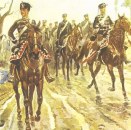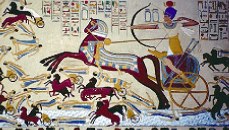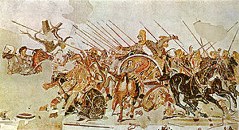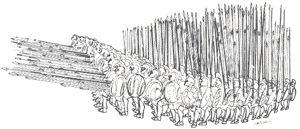Armies - Historical Sketch



Images. 1) Prussian Hussars, early 19th century. 2) Hyksos. 3) The Battle of Issus 333 B.C. Alexander of Macedonia, defeated the Persian forces led by Darius III of Achaemenid Persia.
1) Ancient armies.
The military forces of the earliest times were little better than armed multitudes, possessed of a certain amount of rough organization, but unable to travel great distances, or carry out any very serious operations. In the 16th century B.C. the Egyptian forces under Sesostris, numbering, according to tradition, over half a million men, conquered and laid waste all the country as far east as India. Chariots and horsemen were important factors in the Egyptian method of fighting; but victory depended on the infantry, which formed the bulk of the army. The reverse was the case with the well-organized Persian armies which existed about a thousand years later, the horsemen for exceeding the footsoldiers. The Spartans, Athenians, and Macedonians were the first European nations to possess good armies. The general Greek military organization was on a militia basis, and no standing army was maintained. Every freeman was bound to take up arms at the age of eighteen. For the first two years he served at home, but after that, until he was forty, in any foreing country where the state was at war. The most important element in the army was infantry, which was divided into two main branches, the hoplitai and psiloi. The former were heavy troops, and in action were arranged in the favourite Greek fighting formation, the phalanx - a body of 4,000 men drawn up in lines from eight to sixteen deep. The psiloi were lightly-armed troops, who carried out the skirmishing duties of the army, harassed the enemy, and hung round the flanks and rear of the phalanx with the cavalry in time of battle. The Greek army reached the zenith of its efficiency under Alexander. The recruiting, transport, and provisioning branches were all well organized.

The phalanx (plural phalanxes or phalanges). In ancient warfare, a close, deep formation of heavily armed (armed with large shields, short swords, pikes or spears) infantry adopted by the ancient Greek armies. The phalanx soldiers, called hoplites, were drawn up in close aray, shoulder to shoulder, in a line 8 ranks deep, as a rule though, the Thebans used a formation 25 ranks to even 50 ranks deep. The Macedonian phalanx was an improvement on the Greek forma- tion, in that the men stood in a rathermore open order, 16 ranks deep, armed with spears 21 feet long (the sarissa). In this way the spears of the first 5 ranks formed an impenetrable hedge, protecting the front rank. The phalanx there- fore presented a shield wall and a mass of spear points to the enemy, making frontal assaults much more difficult. To prevent flank attacks, Philip II placed cavalry and light infantry on the sides. In 324 B.C. Alexander made only the three front and the rear ranks spearmen; the intermediate ranks were composed of archers and javelin men. The phalanx was vulnerable because of its lack of maneuverability, and its tendency to fall into disarray when not on level ground. At the battle of Pydna (168 B.C.) the more flexible Roman legion destroyed The Macedonian phalanx and rendered it obsolete.
The Romans had originally employed the phalanx themselves, but gradually evolved more flexible tactics resulting in the three-line Roman legion of the mid-Roman Republic. The phalanx continued to be employed by the Romans as a tactic for their third military line or triarii of veteran reserve troops armed with the hastae or spear
Add. Info: The Spartan Army was the military force of Sparta, one of the leading city-states of ancient Greece. The army stood at the centre of the Spartan state, whose citizens' primary obligation was to be good soldiers. Subject to military drill from infancy, the Spartans were one of the most feared military forces in world history. At Sparta's heyday in the 6th to 4th centuries BC, it was commonly accepted that "one Spartan was worth several men of any other state" The Spartan ascendancy did not last long. Like the other Greek states, the Spartan army was an infantry-based army fighting in the Phalanx formation.
The Macedonian army or army of Macedon is considered to be among the greatest and most complete well co- ordinated military forces of the ancient world. It became a formidable force known from history first under the rule of King Philip II of Macedon and then his son, Alexander the Great.
The Macedonian phalanx itself was not very different from the hoplite phalanx of other Greek states as a formation. As an evolution of the hoplite phalanx, it featured improved equipment, training, and tactics. In Phillip's and Alexander's time, the Macedonian phalanx had clear technical superiority. The Companion cavalry, or Hetairoi, were the elite arm of the Macedonian army, and have been regarded as the best cavalry in the ancient world. The Macedonian foot soldiers were formed into an infantry formation developed by Philip II and used by his son Alexander the Great to conquer the Persian Empire and other armies. These infantrymen were called Pezhetairoi-- the Foot Companions—and made up the dreaded Macedonian Phalanx.
The Greeks fought mainly as heavy infantry, and thus in the Persian Wars the Greeks emerged victorious despite far smaller numbers. The Persian army depended on archery, mobility, and cavalry, and while these tactics were effective on the vast plains of the east, in confined areas they could be defeated easily. Alexander the Great used his force, with heavy cavalry, to conquer the Persian Empire. Source. Wikipedia.org.
The Roman armies which ruled the world from about the 3rd century B.C to the 8th A.D were probably the finest comparatively, that have ever existed. They were at first formed entirely of militia. Every one between the ages of seventeen and forty-six - except the very lowest and poorest class - could be called on to bear arms in the service of the state. Consular armies were raised every year for some expedition or campaign, at the end of which they returned home and were disbanded. This course was found impracticable for some armies which were employed in very distant lands, and so they were often kept under arms for several years, a fact that eventually led to the formation of a standing army army distinct from the milita, by which it was augmented for the prosecution of great foreign wars. The legion was the chief feature of Roman armies. It was composed of about 4,000 infantry and 300 cavalry, and was lighter and more extended in formation than the Greek phalanx. It was consequently superior in mobility, and better adapted for effensive operations. The infantry of the legion were divided into four classes - hastati, young men lightly armed, forming the first line; principes, principes, heavily-armed men of great strength, forming the second line; triarii, the oldest men, heavily armed and armoured, in the thrid line; and velites, or light troops, corresponding to the Greek psiloi. The first three classes were each divided into ten manipuli, commanded by centurions. After the adoption of standing armies the legion was increased to over 6,000 men, and was divided into ten cohorts.
Infantry was still the main element in a army throughout the long period during which the Frank and German armies ruled Europe, after they had overthrown the Roman power. All freemen bore arms and in war were obliged to follow and obey the rulers of their respective tribes. No standing army was kept up, but the warlike spirit of the nation was so strong that it was considered the hightes honour to bear arms, and every man was practically a trained soldier.
2) Medieval armies.
About the 9th century, the "feudal system", which had been slowly developing for some time pas, finally estalished itself as the basis of European army organization. It arose originally through the young men of a nation gathering round the nobles, serving under their banners in war time, and garrisoning their castles during peace. Each of these bands practically formed a small standing army, being paid for their services by gifts or booty or land. The profession of arms came to be regarded in time as an honourable and profitable calling, and the bands grew stronger and more numerous. The nobles owed allegiance to the king, and when the latter required an army it was formed of these feudal bands, supplemented by a levy of militia from the freemen of the nation. The chief arm of the feudal armies was cavalry. It was divided into two classes - the knights and their retainers, the men-at-arms; and the hobilers, or light horsemen.